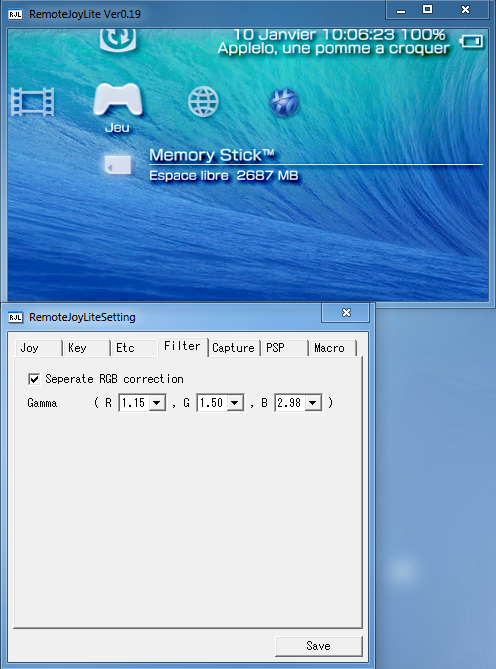

- Remotejoylite fps how to#
- Remotejoylite fps install#
- Remotejoylite fps drivers#
- Remotejoylite fps update#
- Remotejoylite fps full#
Perhaps FRAPS isn't accurate for seeing how much FPS the PSP is putting out. Doesn't seem like a true 60 though so I'll just leave Transfer FPS set to 30 for all my games. Ys Seven is 30 FPS, so looks like I doubled my file size for nothing, but if I enable the option called Vblank Forced Transfer then the FPS for Ys Seven jumps up to 60. I don't mess with Transfer sys address at all and leave Thread priority at 16. TYPE 3 reduces image quality, looks like garbage no reason to ever use it and TEST MODE freezes the image (I have no idea why that happens or what it is for). Virtually no difference between TYPE 1 and TYPE 0. Also experimenting around with "Transfer type" it would seem that TYPE 1 is Progressive and TYPE 2 is Interlaced. "-" is indeed unlimited and the PSP seems capable of 60 maximum. I searched a bit and found a guide for it with some hotkey descriptions and F1 will turn on internal FPS display. ĭisregard what I just typed, as RJL has no documentation that I can find. I set it to 30 FPS and the lag is gone, but FRAPS still reports 60, so not even sure how I can accurately test FPS, guess I'll just leave it set to 30 FPS. I just did a test, default "Transfer FPS" option is "-" which I'm assuming means whatever the PSP can squeeze out (FPS ≤ 60), it doesn't cause Ys Seven to lag but it causes some of my other games to have a frame rate drop. The content remains unbiased and authentic.-Perhaps FRAPS isn't accurate for seeing how much FPS the PSP is putting out. However, it does not affect our editorial integrity. The above article may contain affiliate links which help support Guiding Tech. 64-bit Windows users, just wait from my next post to experience the fun. Sound may be an issue as they will still be coming from the PSP but a pair of headphones should take care of that. I am sure you will love to play your favorite games on the bigger screen. You can even use your keyboard keys to play the games. To activate full-screen mode, simply double click on the plugin display screen. You can now explore the plugin on your computer to control various aspects like frame rate and screen resolution. Step 6: After the PSP restarts, you can run the RemoteJoyLite_en.exe file fromRemoteJoy Lite\GUI to get the PSP screen displayed on your computer. After the plugin is activated, reset PSP VHS recovery. Step 5: Having done that, connect the PSP to your computer without mounting memory stick and activate the RemoteJoy Lite plugin in PSP’s recovery menu. If your PSP seplugin does not have the files, you can simply copy and paste them. Step 4: Open the game.txt and vhs.txt file in the seplugin folder in your computer and copy the text in the PSP’s vhs.txt and game.txt file. If you don’t have the folder already, you will have to create it.
Remotejoylite fps drivers#
Step 3: After the drivers are installed on your computer, mount the PSP Memory Stick and copy the RemoteJoyLite.prx file to Memory Stick\seplugin folder.
Remotejoylite fps how to#
(Here’s the difference between 32-bit and 64-bit and how to find out which one you are running)
Remotejoylite fps install#
If you are running 64-bit OS, you will have to wait for my next post where we will show you how you can install the drivers in there as it gets a little tricky. The drivers work fine for users using Windows 32-bit. Step 2: Navigate to RemoteJoy Lite\drivers\usb_driver and install the PSPDriver on your computer. Download RemoteJoy Lite package on your computer and extract it to a folder. Step 1: Make sure PSP is not in USB auto mount mode and it’s not connected to your computer.
Remotejoylite fps update#
If you don’t have the custom firmware running you might have to update your firmware and install it before you can continue. Note: You will require a PSP running on a custom firmware 6.60.
Remotejoylite fps full#
Today we will see how you can connect PSP to your computer and play all the games in full screen. All we have is a USB cable output and that’s not enough to just plug and play…or is it? If only a PSP had an HDMI output, we could have easily connected it to a bigger screen to increase the fun, but unfortunately that’s not the case.

While playing a game on the 4.3” PSP screen, I bet you must have wondered how it would feel if you could connect the console to your desktop or laptop and play the same game on the big screen.


 0 kommentar(er)
0 kommentar(er)
